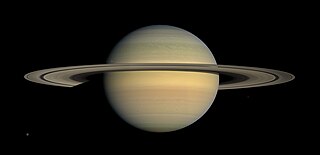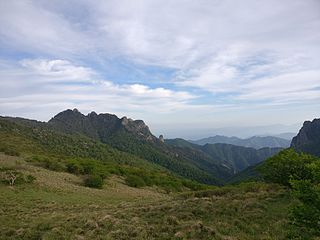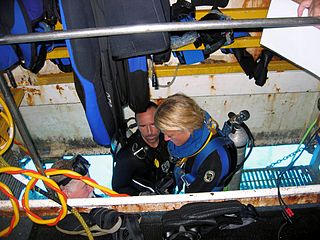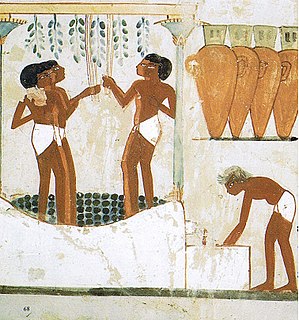
The Moon is an astronomical body that orbits Earth as its only natural satellite. It is the fifth-largest satellite in the Solar System, and the largest among planetary satellites relative to the size of the planet that it orbits. The Moon is, after Jupiter's satellite Io, the second-densest satellite in the Solar System among those whose densities are known.

Nuclear winter is a severe and prolonged global climatic cooling effect hypothesized to occur after widespread firestorms following a nuclear war. The hypothesis is based on the fact that such fires can inject soot into the stratosphere, where it can block some direct sunlight from reaching the surface of the Earth. It is speculated that the resulting cooling would lead to widespread crop failure and famine. When developing computer models of nuclear-winter scenarios, researchers use the conventional bombing of Hamburg, and the Hiroshima firestorm in World War II as example cases where soot might have been injected into the stratosphere, alongside modern observations of natural, large-area wildfire-firestorms.

Dendrochronology is the scientific method of dating tree rings to the exact year they were formed. As well as dating them this can give data for dendroclimatology, the study of climate and atmospheric conditions during different periods in history from wood.

Saturn is the sixth planet from the Sun and the second-largest in the Solar System, after Jupiter. It is a gas giant with an average radius about nine times that of Earth. It has only one-eighth the average density of Earth; however, with its larger volume, Saturn is over 95 times more massive. Saturn is named after the Roman god of wealth and agriculture; its astronomical symbol (♄) represents the god's sickle.

The Cassini–Huygens space-research mission, commonly called Cassini, involved a collaboration between NASA, the European Space Agency (ESA), and the Italian Space Agency (ASI) to send a probe to study the planet Saturn and its system, including its rings and natural satellites. The Flagship-class robotic spacecraft comprised both NASA's Cassini probe and ESA's Huygens lander, which landed on Saturn's largest moon, Titan. Cassini was the fourth space probe to visit Saturn and the first to enter its orbit. The two craft took their names from the astronomers Giovanni Cassini and Christiaan Huygens.

Glacier National Park is an American national park located in northwestern Montana, on the Canada–United States border, adjacent to the Canadian provinces of Alberta and British Columbia. The park encompasses over 1 million acres (4,000 km2) and includes parts of two mountain ranges, over 130 named lakes, more than 1,000 different species of plants, and hundreds of species of animals. This vast pristine ecosystem is the centerpiece of what has been referred to as the "Crown of the Continent Ecosystem," a region of protected land encompassing 16,000 square miles (41,000 km2).

Michael Evan Mann is an American climatologist and geophysicist, currently director of the Earth System Science Center at Pennsylvania State University, who has contributed to the scientific understanding of historic climate change based on the temperature record of the past thousand years. He has pioneered techniques to find patterns in past climate change, and to isolate climate signals from noisy data.

Tokyo Institute of Technology is a national research university located in Greater Tokyo Area, Japan. Tokyo Tech is the largest institution for higher education in Japan dedicated to science and technology, and is generally considered to be one of the most prestigious universities in Japan.

Terra is a multi-national NASA scientific research satellite in a Sun-synchronous orbit around the Earth. It is the flagship of the Earth Observing System (EOS). The name "Terra" comes from the Latin word for Earth. A naming contest was held by NASA among U.S. high school students. The winning essay was submitted by Sasha Jones of Brentwood, Missouri. The identifier "AM-1" refers to its orbit, passing over the equator in the morning.

The Qinling or Qin Mountains, formerly known as the Nanshan and sometimes called the "Szechuan Alps", are a major east-west mountain range in southern Shaanxi Province, China. The mountains provide a natural boundary between North and South China and support a huge variety of plant and wildlife, some of which is found nowhere else on earth.
The Cornell Lab of Ornithology is a member-supported unit of Cornell University in Ithaca, New York which studies birds and other wildlife. It is housed in the Imogene Powers Johnson Center for Birds and Biodiversity in Sapsucker Woods Sanctuary. Approximately 250 scientists, professors, staff, and students work in a variety of programs devoted to the Lab's mission: interpreting and conserving the Earth's biological diversity through research, education, and citizen science focused on birds. Work at the Lab is supported primarily by its 75,000 members. The Cornell Lab publishes books under the Cornell Lab Publishing Group, a quarterly publication, Living Bird magazine, and a monthly electronic newsletter. It manages numerous citizen-science projects and websites, including the Webby Award-winning All About Birds.

Pashan is suburb of Pune, India. It is located off the Mumbai-Bangalore national highway, by-passing Pune city. Pashan road serves as the main approach road for Mumbai-Pune expressway. Pashan is bordered by Baner in north, Sus on west, Bavdhan in south and Pune University in east. Pashan is mostly a residential suburb of Pune and large portions are occupied by various governmental and educational institutions. In October 2019, Pashan received more rainfall than the wettest place on Earth.

The Van Allen Probes, formerly known as the Radiation Belt Storm Probes, were two robotic spacecraft that were used to study the Van Allen radiation belts that surround Earth. NASA conducted the Van Allen Probes mission as part of the Living With a Star program. Understanding the radiation belt environment and its variability has practical applications in the areas of spacecraft operations, spacecraft system design, mission planning and astronaut safety. The probes were launched on 30 August 2012 and operated for seven years. Both spacecraft were deactivated in 2019 when they ran out of fuel. They are expected to deorbit during the 2030s.
Malcolm K. Hughes is a meso-climatologist and Regents' Professor of Dendrochronology in the Laboratory for Tree-Ring Research at the University of Arizona.
The University of Washington firebombing incident was an arson which took place in the early morning hours of May 21, 2001 when a firebomb was set off at Merrill Hall, a part of the University of Washington's Center for Urban Horticulture, causing an estimated $1.5 to $4.1 million in damages. By 2012 four of five accused conspirators behind the attack admitted their guilt in plea bargains. A fifth committed suicide in federal detention while awaiting trial.

Craig B. Cooper is a professional aquanaut from the United States who served from 1991 to 2010 as Operations Manager for Aquarius, the world's only underwater habitat. Cooper is known to fellow divers by the nickname "Coop".

Human uses of plants include both practical uses, such as for food, clothing, and medicine, and symbolic uses, such as in art, mythology and literature. The reliable provision of food through agriculture is the basis of civilization. The study of plant uses by native peoples is ethnobotany, while economic botany focuses on modern cultivated plants. Plants are used in medicine, providing many drugs from the earliest times to the present, and as the feedstock for many industrial products including timber and paper as well as a wide range of chemicals. Plants give millions of people pleasure through gardening.













